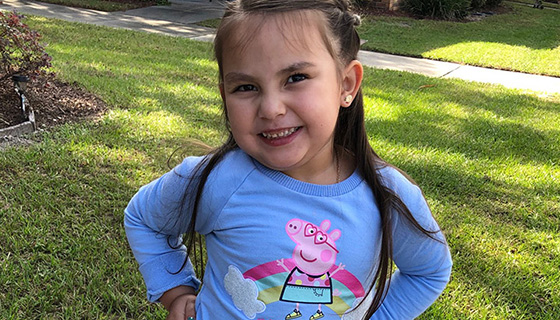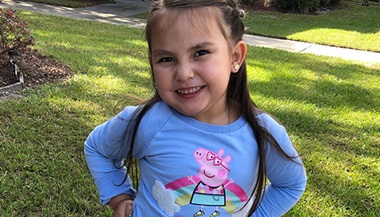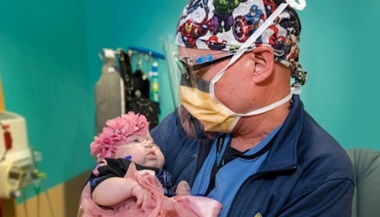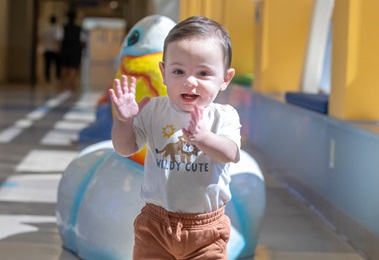Patient Story
Choledochal Cyst: Lyla’s Story
Patient Story Highlights
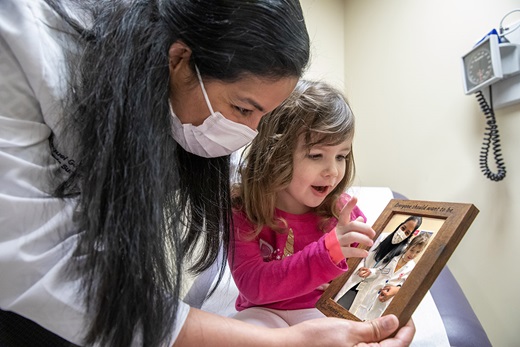
Lyla is a happy toddler who loves to swim, sing and eat all kids of different foods. It wasn’t until the summer of 2022, after her third birthday, when her parents noticed she wasn’t eating as much and stomach ache symptoms kept her from all her favorite activities.
“She suddenly had an upset stomach then developed yellow eyes and was jaundiced,” says her mother, Sarah. “She was in a lot of pain.”
The family met with Lyla’s pediatrician thinking a stomach bug was the culprit. When her symptoms seemed to linger for several days and get worse though, the pediatrician ordered bloodwork and urged the family to get to Johns Hopkins All Children’s Hospital’s pediatric Emergency Center. Staff noticed Lyla had elevated bilirubin levels — indicating potential problems with her hepatobiliary system, so she underwent various exams and an ultrasound. Then a CT scan showed a choledochal cyst, a cystic malformation of the common bile duct, but at first it was unclear how severe her case would be.
“Choledochal cysts are not very common,” says Raquel Gonzalez, M.D., pediatric and critical care surgeon at Johns Hopkins All Children’s Hospital in St. Petersburg, Florida. “In situations like these where a diagnosis is challenging or complex, I like to draw the family pictures — first, of the normal anatomy, and then of the variation the child has. In this case, I drew them a picture of a normal common bile duct, then of the abnormal duct she had. Finally, I reviewed the CT scan images with them to help them further understand.”
The surgery to remove the cyst took about five hours. As part of the surgical intervention, Gonzalez removed the cyst, and the gallbladder, which is connected to the common bile duct, and reestablished continuity between the liver and intestines.
“The surgery is complex since it requires reconstruction of the hepatobiliary system,” Gonzalez says. “When you remove the common bile duct, you hinder the liver from draining bile into the intestine, like it normally does — which would eventually lead to liver failure, if left this way. In order to ensure biliary drainage you need to connect a segment of small intestine to the liver, and then connect the other end of the small intestine to another portion of the small intestine.
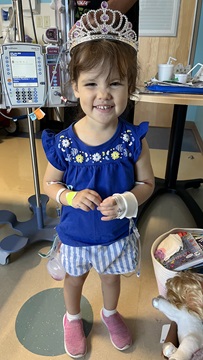
“I get so emotional talking about it,” Sarah says while holding back tears. “She was in the hospital 11 nights and had surgery after three to four days in, and it was so tough because she couldn’t eat. She just had IV fluids, tubes coming out of her nose and a pouch coming from her stomach.”
Thankfully, Gonzalez says Lyla recovered phenomenally and she showed prompt progress as her bilirubin levels quickly decreased post-surgery. As the days went by, Lyla slowly started to return to her bubbly personality. Her mom says she barely needed pain medications thanks to a superstar team of providers in the hospital caring for her.
“We were just amazed by all the staff,” adds Sarah. “All the nurses were incredible and so helpful and teaching us how to do everything and Dr. Gonzalez, the way she explained everything to us and was able to explain so we understood, it was really special and we feel so lucky it was her.”
Lyla has a good prognosis, thanks to surgery and removal of the cyst. She still has to see Gonzalez for follow ups throughout the year to ensure other complications do not develop, but her care team is impressed with the way this family handled what ended up being a very serious tummy ache.
“Every child, inevitably, will develop some sort of abdominal pain throughout their childhood,” says Gonzalez. “However, abdominal pain associated with jaundice — yellow skin or eyes and/or pale color stools is not normal — that is something to be concerned about, and requires a visit to their pediatrician’s office or the emergency room.”
While Lyla may have left the hospital with a surgery scar on her tummy, her mom says as soon as they arrived back home she was back to her normal self and back at day care shortly after. Now that she’s left without her gallbladder, she has to avoid fried foods but mom says she’s back to being a good eater.
“She doesn’t complain about her belly anymore,” says Sarah. “Her personality has really come out and she’s much more wild and has got a lot of energy!”


